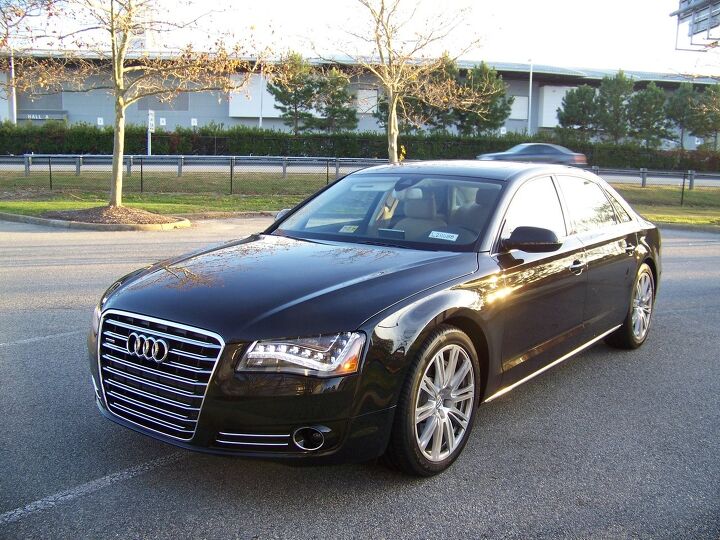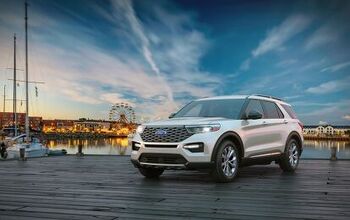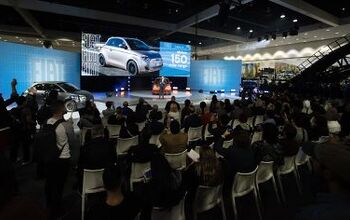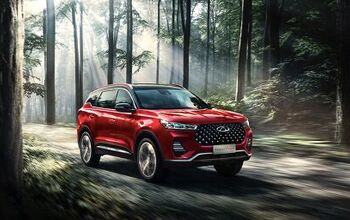Review: 2011 Audi A8 L 4.2 FSI
“Didn’t he say they had only one of the new A8s?”
“That’s an A4, Dad.”
Some people will walk away at this point, refusing to even consider spending $85,000+ on a car that can be so easily confused with one costing less than half as much. A similar problem killed GM’s luxury car sales back in the second half of the 1980s. But, by walking away, are these buyers missing out on the best large luxury sedan on the market?
Personally, I’ve long been okay with the “same sausage, different lengths” design philosophy. I don’t expect a size 12 shoe to be styled differently than a size 8, at least not if I like the design. Prefer the agility of a compact? Get the A4. Need the XXL, because you and all of your buddies must duck when walking through standard doorways? The A8 L could well be the car for you.
The problem, for me: the new Audi A8 doesn’t look enough like the A4. With the latest iterations of the A3, A4, A5, and Q5, Audi seemed to have finally figured out how to attractively incorporate a supersized grille into the face of a car. With these models, the outer thirds of the front fascia extend a little lower than the center section, and a bumper bar splits the grille horizontally, keeping it from appearing too tall. Well, with the new A8 a vastly oversized, unsegmented grille extends all the way to the fascia’s flat bottom edge. And, to make sure no one somehow misses it, Audi affixed eight pairs of chrome strips. Harley Earl would have loved it. Ditto the $1,400 all-LED headlamps. A“because we can” affectation, the hockey stick pattern formed by the LEDs has no relation to the rest of the car’s design.
Then there’s the side view. With the new A4 and A5, Audi located the front differential immediately behind the engine so that the front axle could be shifted forward a half-foot, vastly improving the car’s proportions. They’ve performed no such trickery with the new A8. Combining Audi’s traditional powertrain layout with a hood high enough to meet the latest European pedestrian safety standards yields an unsightly amount of front overhang.
Lastly, the lower bodysides of latest A4 have an upsweeping character line to lend visual interest. In contrast, the bodysides of the new A8 are relatively boring. A pair of character lines do subtly curve towards each other, but this only makes the rear of the car appear undersized and underdeveloped. Only through its sheer sheer size—207.4 inches long, 76.7 inches wide—and that of its glitzy grille does the A8 possibly command the “road presence” expected of this class of sedan. The previous A8 was considerably more attractive.
The 2011 Audi A8s interior design is an evolution of the previous car’s; not a bad thing, since the previous car’s interior was Germany’s most attractive. The Alcantara that now graces the door panels looks better in richer shades than the “as-tested” light beige. The sportily sloping center stack has been further reclined to create space for the MMI (Audi for iDrive) controls ahead of the shifter (they used to be behind it). To avoid obstructing these controls, the new all-electronic shifter is a much lower, fighter jet-inspired T. Knobs continue to be employed for the most basic HVAC and audio system functions.
When not in use, the display screen retracts into the instrument panel. This cleans up the IP—but the display is almost constantly in use. Even the seat adjustments are displayed, which is actually a good thing because they are so numerous. In general, so many adjustments are available for so many things that the average owner will probably never be aware of, much less be able to figure out how to use, 90 percent of them. It’s a high-end cell phone disguised as a large luxury sedan.
Option the new A8 to the hilt and even rear seat passengers can suffer from control overload. But the tested car included a mere $8,400 in options and so lacked power rear seats, dual-zone rear HVAC, and the dual-display entertainment system. Even so, each rear door included four switches and a button to operate four sunshades (overhead, each side window, and the rear window), both power windows, and a venting rear panel in the optional panoramic sunroof.
Oddly, given this car’s mission, seat comfort front and rear is just okay. In the traditional Audi fashion the seats are firm and lacking in contour. Those seeking lateral support should kick in another $2,000 for the Premium Package, which includes power-adjustable bolsters. Roominess, on the other hand, is outstanding. In the extended length L, nearly all of the lengthier wheelbase goes to the rear seat, yielding 42.9 inches of legroom—more than in the front seat. In the Hyundai Equus I complained about the lack of toe space beneath the front seats. In the A8 L my toes couldn’t reach the front seats. Perceived roominess is even better than the specs suggest, partly because Audi hasn’t run with the crowd to adopt ridiculously high beltlines—the windows remain relatively large. Unless you and your buds all play center, or you want to feel like a child again while riding in the back seat, there could even be too much room.
Most luxury car makers have been steadily enlarging the size of their engines. BMW went from a 4.0 to a 4.4 to a 4.8, Mercedes to a 5.5. Both are now downsizing their V8s, but are adding turbos to simultaneously boost power output. Even Hyundai plans to bump its 4.6-liter V8 to a full 5.0 next year. In contrast, Audi has been offering a smallest-in-class unblown 4.2-liter V8 for nearly two decades. The engine has received various tweaks, some of them substantial, along the way. The latest revision yields 372 horsepower, up 22 from last year and nearly 100 from the original. Wringing 372 horsepower from 4.2 liters—Mercedes gets only ten more out of its 5.5—necessarily requires lots of revs, 6,800 in this case. Put another way, there’s less power at low-to-moderate RPM with a smaller engine, and the 4.2’s torque output of 328 pound-feet at 3,500 trails the Mercedes’ 391 at 2,800, much less the turbocharged V8 in the BMW 7.
Personally, I don’t miss the missing torque in the Audi. The relatively small V8 revs so smoothly, and makes such luscious mechanical noises when doing so, that the need to work it harder might well be the opposite of a problem. The A8 might not launch quite as hard as the others, but once moving feels very quick. The new smooth-shifting eight-speed automatic does its part, always seeming to select the proper gear without delay. But if you do want to shift for yourself, paddles are located on the steering wheel.
Working an engine harder often harms fuel economy, and the Audi engine has been a bit of a guzzler in the past. But the EPA rates the 2011 at 17 city, 27 highway—up from 16/23 last year and impressive numbers for such a large, powerful, all-wheel-drive car. The BMW 750Li xDrive and Mercedes-Benz S500 4Matic do far worse: 14/20 and 14/21, respectively.
Shifting the front axle forward in the A4 and A5 also improved their weight distribution. Even without this change, though, the new A8 plows much less in hard turns than the old one did, and generally feels more agile. Which is not to say agile. The A8 drives a half-size smaller than it actually is, but this is a half-size smaller than XXL. Typical of all-wheel-drive Audi’s, the A8 can feel inflexible on dry pavement. Get on the throttle, get off the throttle, it doesn’t matter: the attitude of the chassis doesn’t change. To dial the handling up another notch or two, lend some rear-drive feel to the quattro drivetrain, and perhaps all but eliminate understeer, spend another $2,300 for “Audi drive select plus,” which includes active steering and an active, torque-vectoring rear differential.
“Audi drive select” (without the “plus”) is standard, so the throttle, steering, suspension (air springs and adaptive struts), and seat belt tensioners (go figure) can each be independently set to Comfort, “Dynamic” (sport), or Auto. With most such systems the differences between settings can be difficult to discern. Not so with Audi’s. Set the steering and suspension to “comfort,” and the car floats and wallows. “Auto” and “Dynamic” should be the only options. Dial both up to “dynamic,” and the steering becomes –if anything– overly firm, while the suspension becomes much tighter. No one else in the segment offers steering nearly this firm—the difference is easily detectable even while driving straight down the freeway. Move the wheel even a fraction of an inch and the car responds immediately. But all is not perfect: like the ultra-firm steering in a 1980s Detroit-issue Audi-fighter, though certainly not to the same extent, the steering’s weightiness feels artificial and doesn’t build progressively as the wheel is turned.
Ride quality suffers a bit in “Dynamic,” but remains very comfortable. A rock-solid, quiver-free body structure helps. Especially on concrete, road noise is more of an issue in any setting. There’s not a lot of it, but some competitors are nearly silent. The tested car did have the optional 20-inch high-performance tires; the standard 19s might be quieter.
Pack a large aluminum body chock full of technology, and the price isn’t going to be low. The 2011 Audi A8 starts at $78,925. The long, with some additional standard equipment: $84,875. Even lightly optioned, as in the case of the tested car, the price tops $94k. Load it up and you’re over $110k. This might seem pricey, but based on TrueDelta’s car price comparison tool a similarly-equipped BMW 750Li costs about $10,000 more.
The new Audi A8 is easily the sportiest car in the segment. Even BMW has gone soft in comparison, and the new 7 is also considerably more expensive. Not that the new A8 is perfect. The car’s exterior could be both more distinctive (aft of the grille) and more attractive (including the grille). The relatively small V8 doesn’t churn out pavement-rippling torque; with all wheels driven, the chassis could handle far more. Even the car’s technical excellence can seem a little cold—some competitors feel more “natural.” But then no car is perfect. If you’re a driving enthusiast ISO a very large car, the A8 wins by just about any objective measure, and by many subjective measures as well.
Michael Karesh owns and operates TrueDelta, an online source of automotive reliability and pricing data.
Lee “Pete” Canupp of Checkered Flag Audi in Virginia Beach, VA, provided the car. Pete can be reached at 757-490-1111.Michael Karesh lives in West Bloomfield, Michigan, with his wife and three children. In 2003 he received a Ph.D. from the University of Chicago. While in Chicago he worked at the National Opinion Research Center, a leader in the field of survey research. For his doctoral thesis, he spent a year-and-a-half inside an automaker studying how and how well it understood consumers when developing new products. While pursuing the degree he taught consumer behavior and product development at Oakland University. Since 1999, he has contributed auto reviews to Epinions, where he is currently one of two people in charge of the autos section. Since earning the degree he has continued to care for his children (school, gymnastics, tae-kwan-do...) and write reviews for Epinions and, more recently, The Truth About Cars while developing TrueDelta, a vehicle reliability and price comparison site.
More by Michael Karesh
Latest Car Reviews
Read moreLatest Product Reviews
Read moreRecent Comments
- ToolGuy 9 miles a day for 20 years. You didn't drive it, why should I? 😉
- Brian Uchida Laguna Seca, corkscrew, (drying track off in rental car prior to Superbike test session), at speed - turn 9 big Willow Springs racing a motorcycle,- at greater speed (but riding shotgun) - The Carrousel at Sears Point in a 1981 PA9 Osella 2 litre FIA racer with Eddie Lawson at the wheel! (apologies for not being brief!)
- Mister It wasn't helped any by the horrible fuel economy for what it was... something like 22mpg city, iirc.
- Lorenzo I shop for all-season tires that have good wet and dry pavement grip and use them year-round. Nothing works on black ice, and I stopped driving in snow long ago - I'll wait until the streets and highways are plowed, when all-seasons are good enough. After all, I don't live in Canada or deep in the snow zone.
- FormerFF I’m in Atlanta. The summers go on in April and come off in October. I have a Cayman that stays on summer tires year round and gets driven on winter days when the temperature gets above 45 F and it’s dry, which is usually at least once a week.













































Comments
Join the conversation
God if I have to look at another car with small windows, chrome strip at the bottom of the doors, deleted bodyside moldings and an oversize cartoonish grille again I'm going to scream!!!! If I have to suffer with one of these blandified clone sedans of 2010 I will just buy a Genesis dress up the drab exterior with some mud guards and exterior trim and laugh with nearly 50K in the bank with a very good rear drive V8 sedan packed with features. Quote: The previous A8 was considerably more attractive. Agree 100% on that statement.
Audi never changes: The engine is too small; the front is too heavy; the car is too complicated, and at 60,000 miles it will need a very expensive overhaul (at which point most owners will just throw it away for some used car sucker to buy.) It's a shame, really, but it's why I still drive Mercedes and BMW. Oh, and I use real winter tires; I don't need all-wheel drive...no one does.